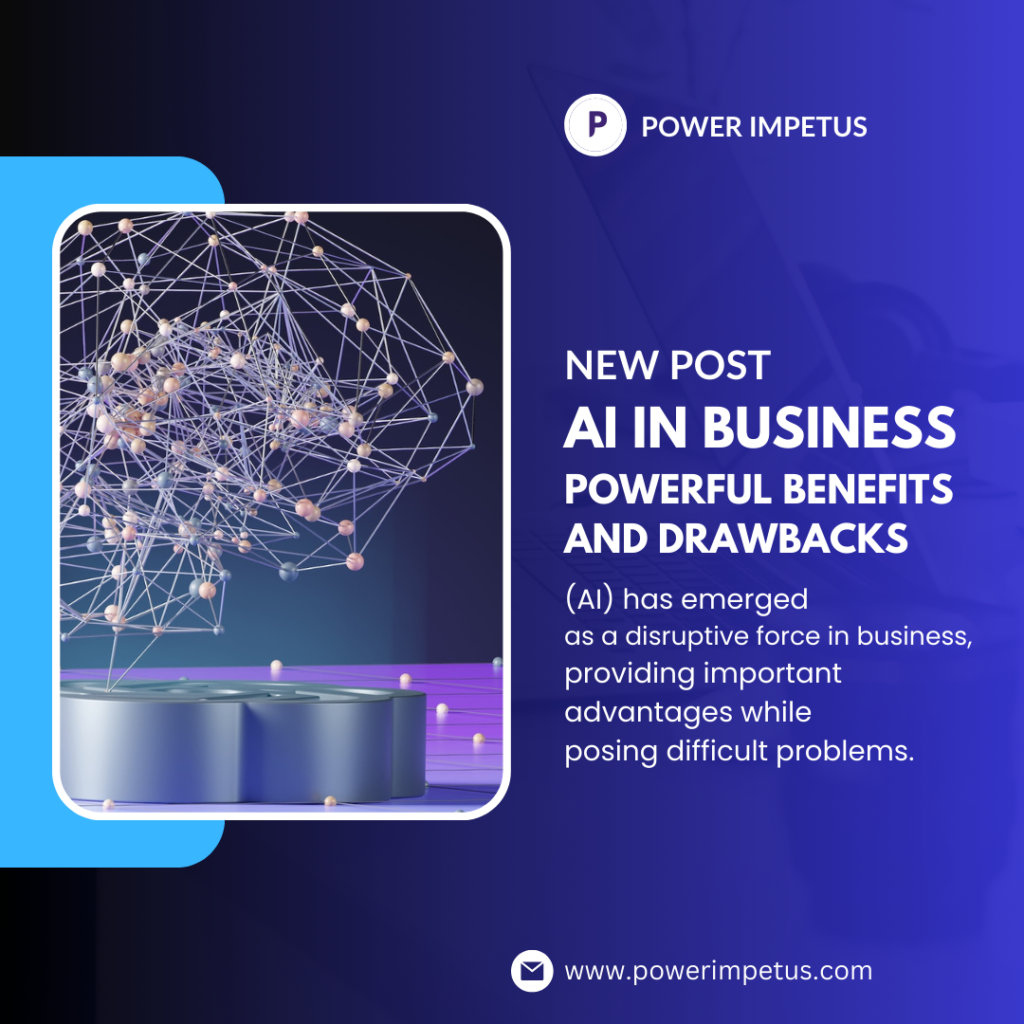Artificial intelligence (AI) has emerged as a disruptive force in business, providing important advantages while posing difficult problems.
We will examine both the significant benefits and potential pitfalls of incorporating AI into corporate processes in this in-depth study.
By the time you finish reading this essay, you will fully grasp how AI is changing the corporate environment and how businesses may take advantage of its promise while avoiding its drawbacks.

Business AI’s Powerful Potential
Enhancing Decision-Making
The ability of AI to improve decision-making in business is one of its most important advantages. Massive datasets may be processed and analyzed in real-time by AI systems, which can then provide information to help with strategic planning and risk analysis.
We’ll look at case studies demonstrating how AI-driven decision support systems have benefited businesses.
Enhanced Effectiveness
AI automates time-consuming and repetitive operations, freeing up staff time for more innovative and valuable activities.
We’ll talk about how AI-driven automation reduces operational expenses by streamlining workflows and increasing overall effectiveness.
Customer Experience Is Improved
The customer experience has been changed by AI-powered personalization and predictive analytics.
Businesses can modify their goods and services in accordance with customer preferences, which boosts client happiness and loyalty.
Examples from the real world will show how effective AI is at interacting with customers.
Market Development and Expansion
Businesses may now find new market opportunities, predict trends, and adjust to shifting consumer preferences thanks to AI.
We’ll look at how AI helps business growth plans and gives it a competitive edge.

Consequences of AI for Business
Data Security and Privacy Issues
AI systems’ vast data collection and use generate serious privacy and security concerns.
The risks of data breaches and other regulatory difficulties associated with AI will be discussed in this section.
Costs of implementation and skill gaps
Even while AI has the potential to reduce costs, its early adoption might be costly. Finding qualified AI professionals might sometimes be difficult.
We’ll talk about how to get beyond these obstacles.
Ethical Conundrums
The usage of AI can lead to ethical concerns, particularly with regard to AI biases and decision-making algorithms.
We’ll talk about the ethical implications of artificial intelligence in business as well as the value of moral standards.
Changes in the Workforce and Job Replacement
The ability of AI to automate jobs could result in employment displacement in some sectors. The necessity for retraining and upskilling will be discussed in this part to guarantee a smooth workforce transfer.
Strategies for Successful AI Integration

How to Choose the Best AI Solutions
It’s critical to select the right AI technologies for your company. We’ll offer advice on the selection procedure and how to match particular business demands with AI solutions.
Compliance with Data Governance
In order to effectively mitigate the dangers connected with AI, effective data governance and compliance mechanisms are crucial. Best practices for data management and upholding compliance will be covered.
Training of employees and change management
It is crucial to prepare the workforce for AI integration. We will look at methods for managing organizational transformation and employee training.
Continuous Monitoring and Improvement
The adoption of AI is a continuous process.
This section explains the significance of continuously assessing AI systems and making the appropriate adjustments.
Case Studies
Amazon: The Debate Over AI Hiring
Consider the example of Amazon’s AI hiring tool, which was abandoned due to worries about discrimination against women in the employment process.
AI-Powered Recommendations on Netflix
Find out how the AI-driven recommendation system at Netflix improves user experience and keeps users interested.
IBM: The Healthcare Impact of AI
Learn how IBM’s Watson is revolutionizing healthcare by giving doctors treatment suggestions and diagnostic insights.
Techniques for Implementing AI Successfully

Clearly Stated Business Goals
Businesses must specify their goals and the issues that AI will be used to address. For implementation to be successful, a defined roadmap is necessary.
Data Management
To guarantee that AI systems make accurate conclusions, effective data governance and quality assurance protocols are essential.
Normative Framework
Create an ethical framework for AI use within the company to address any potential problems or ethical conundrums.
Employee education
To ensure that your team can operate effectively with AI systems and understand their potential and limitations, invest in employee training.
Continuous Assessment
To adjust to shifting business needs and data quality, AI systems should be regularly assessed and enhanced.
AI is a tremendous technology that has the ability to benefit organizations greatly, but it also has potential disadvantages that need to be carefully considered. Recognizing and addressing these issues is essential to successfully integrating AI into business while also maximizing its benefits to spur expansion and innovation. Businesses can maximize the potential of AI and set themselves up for success in the rapidly changing digital environment by carefully following this path.
In conclusion, artificial intelligence (AI) in business is a potent and revolutionary force, and for organizations trying to remain competitive and relevant in the digital era, knowing its advantages and disadvantages is essential.
Thank you for your time!




